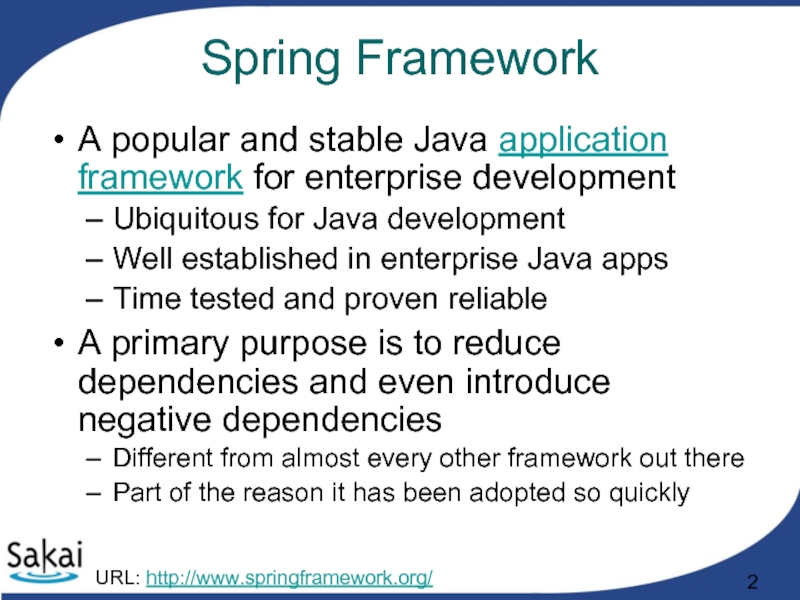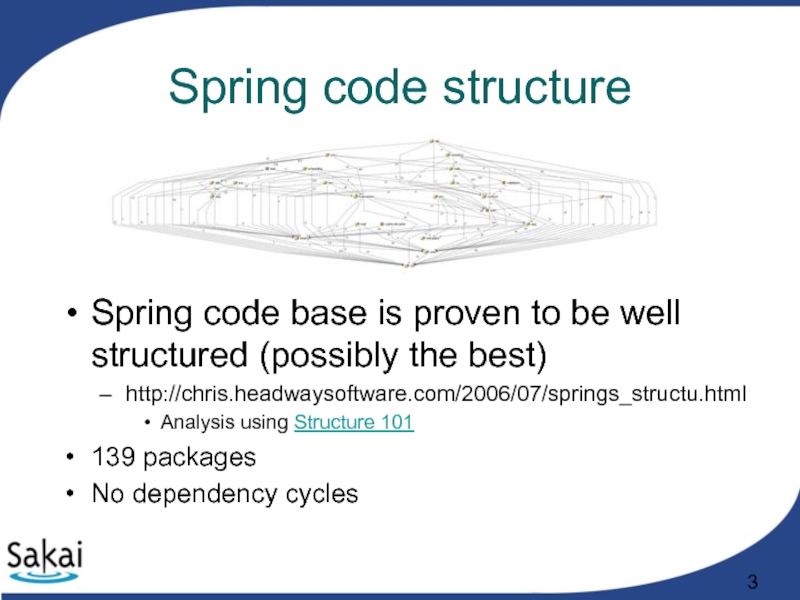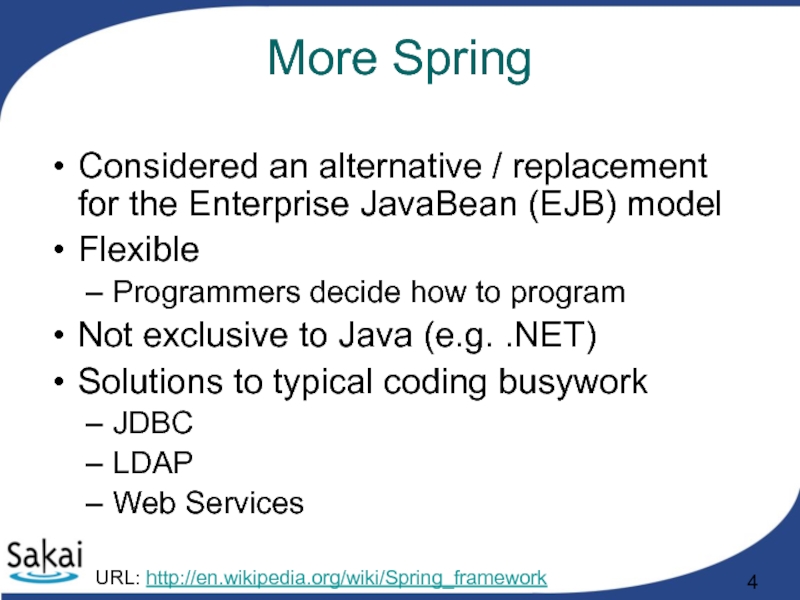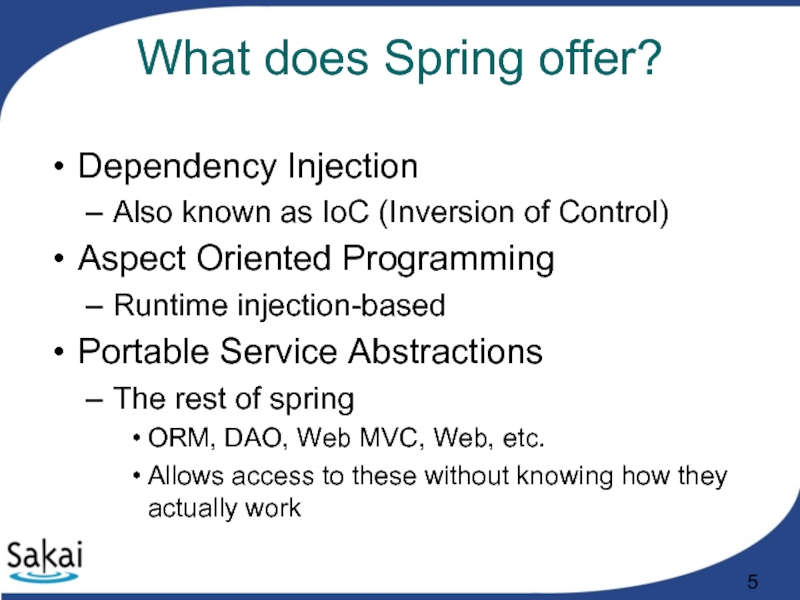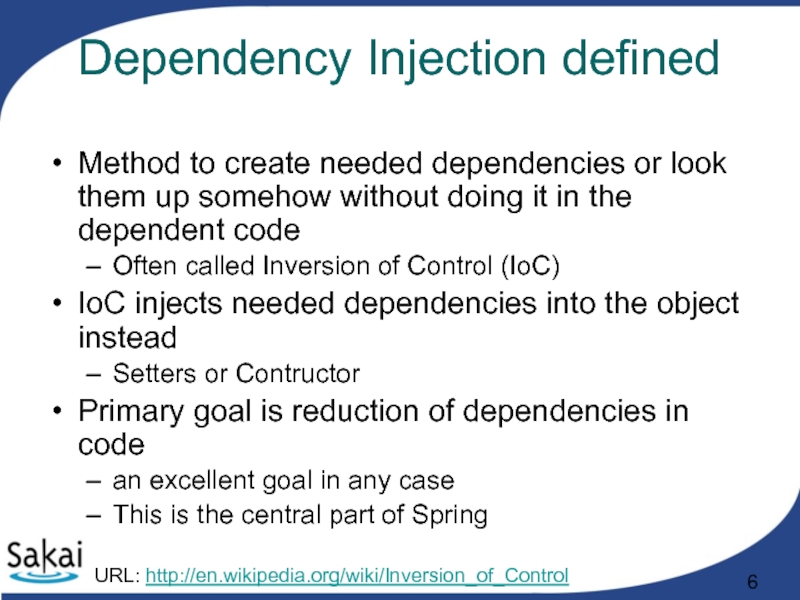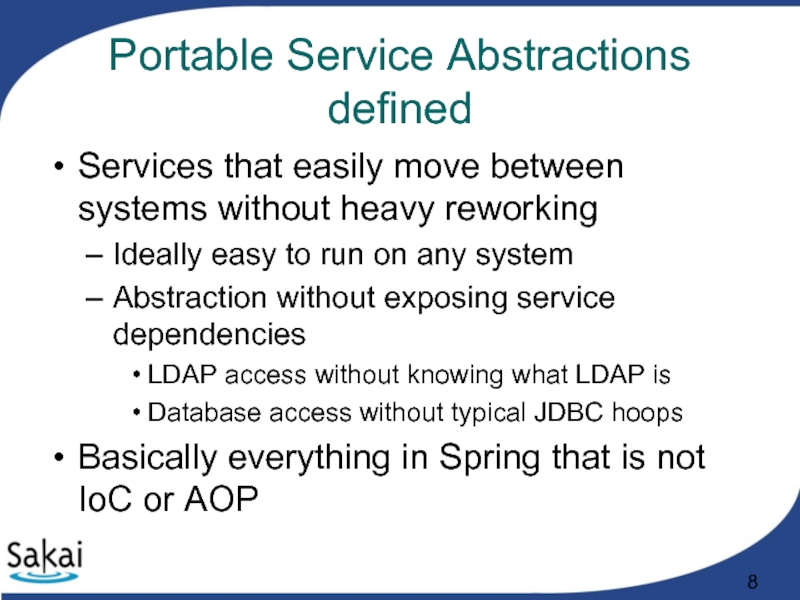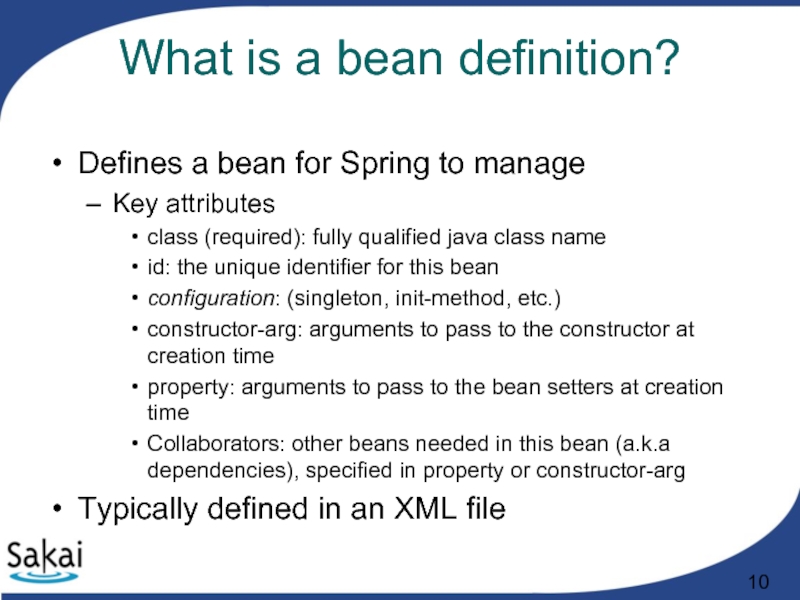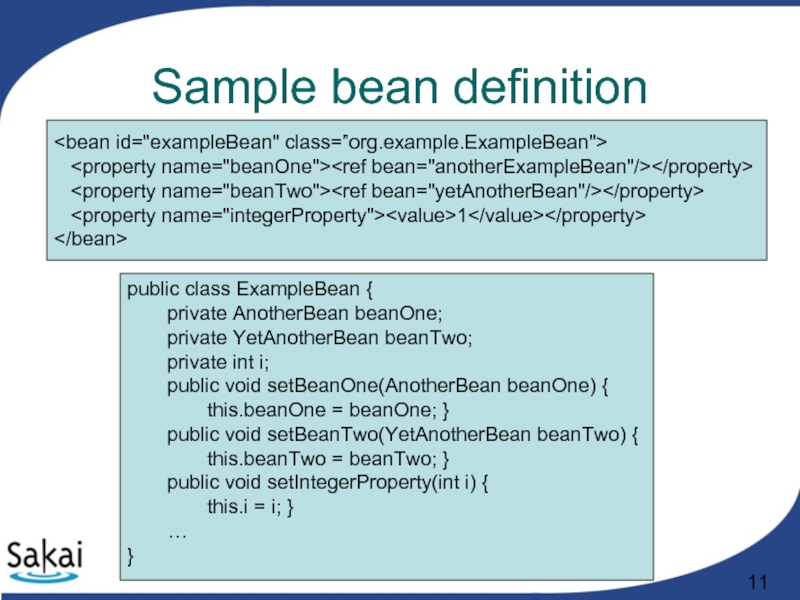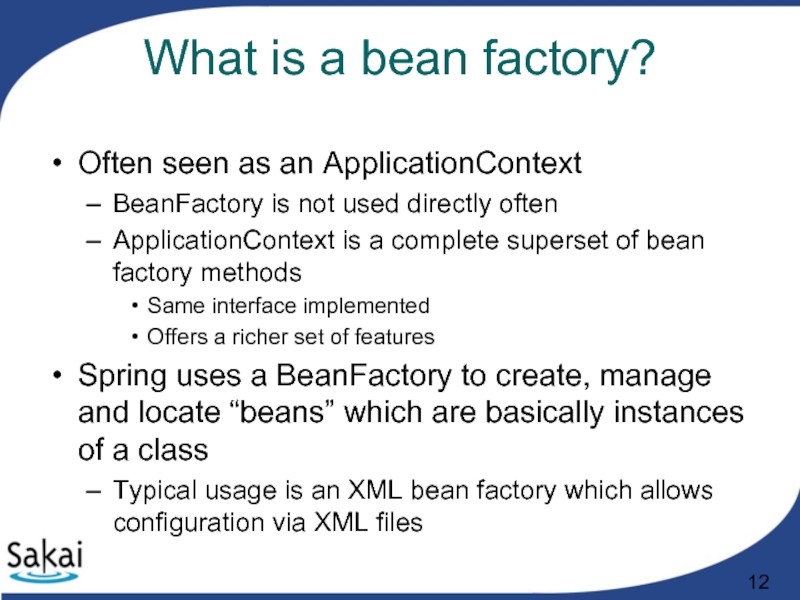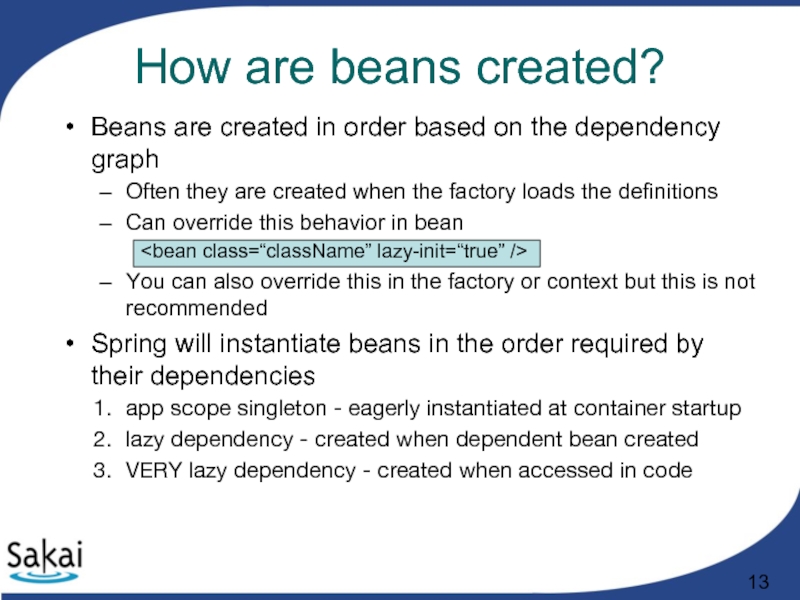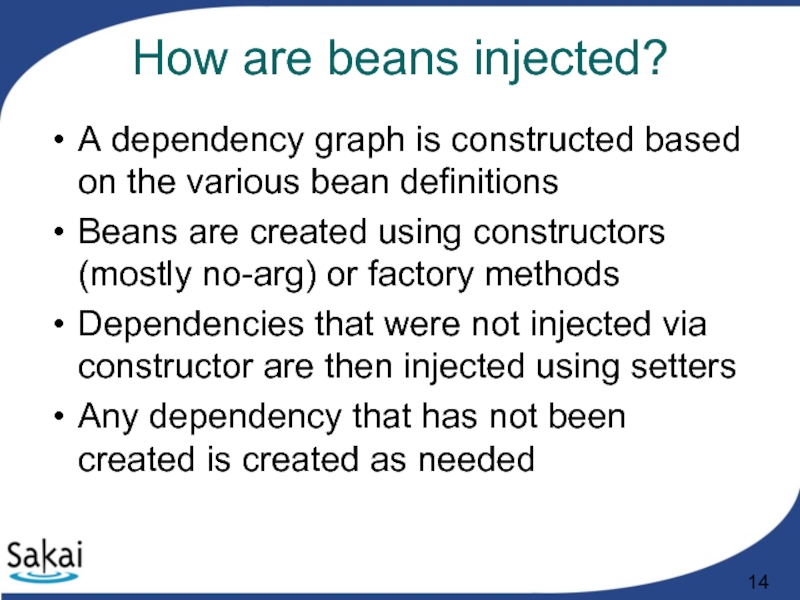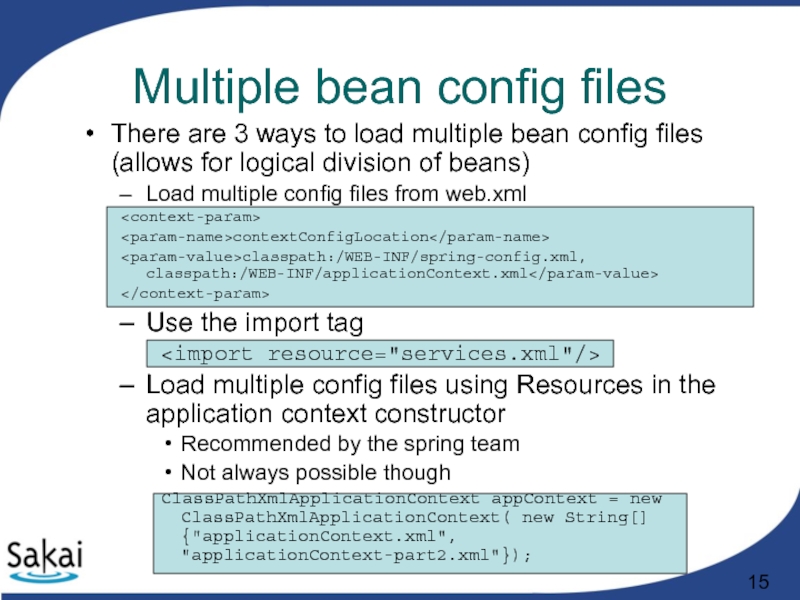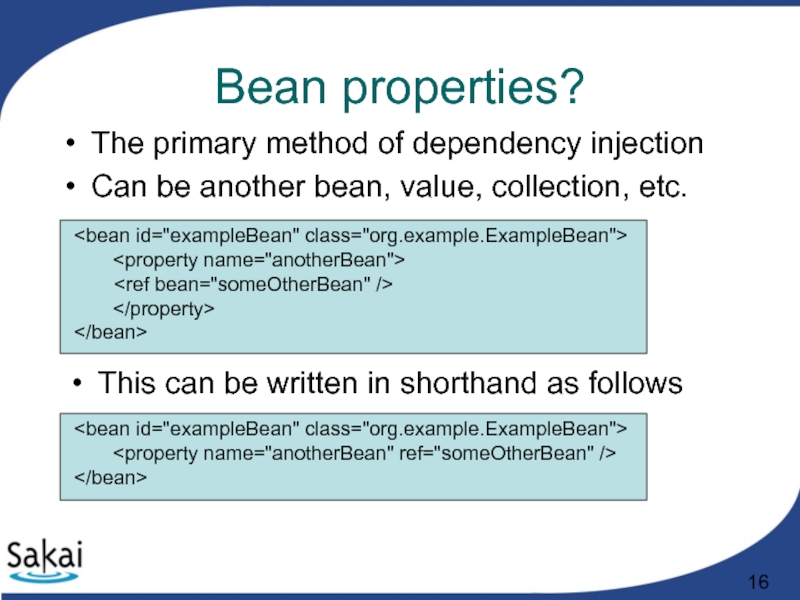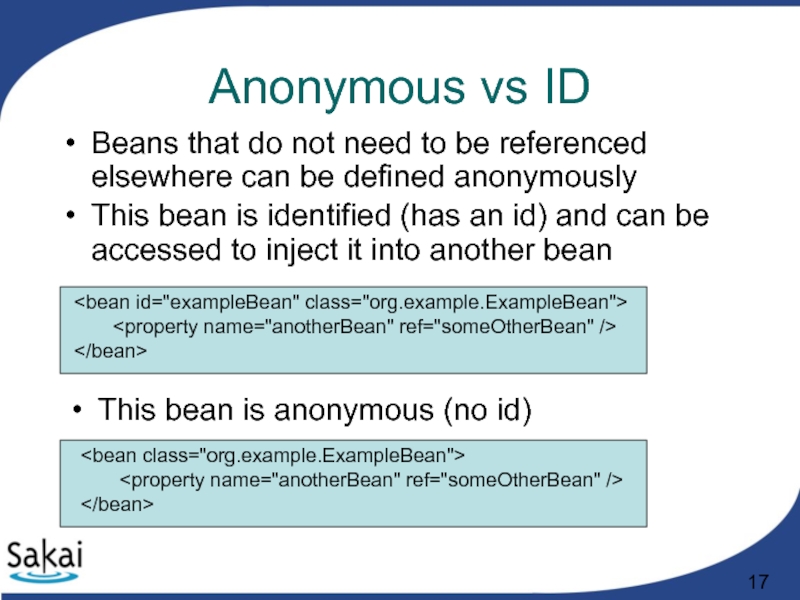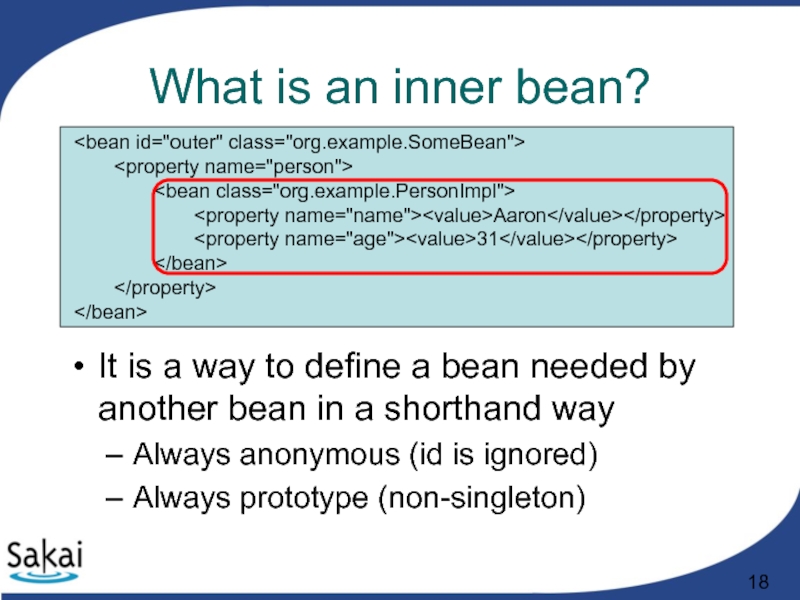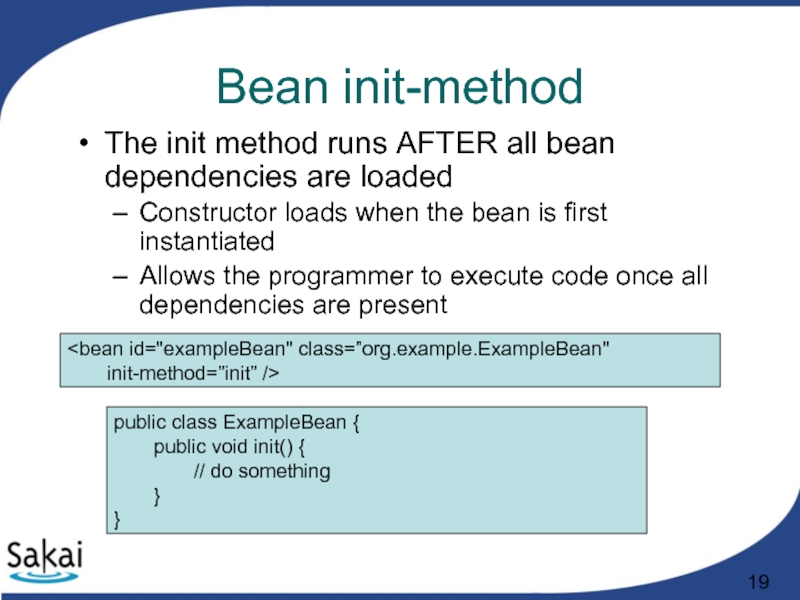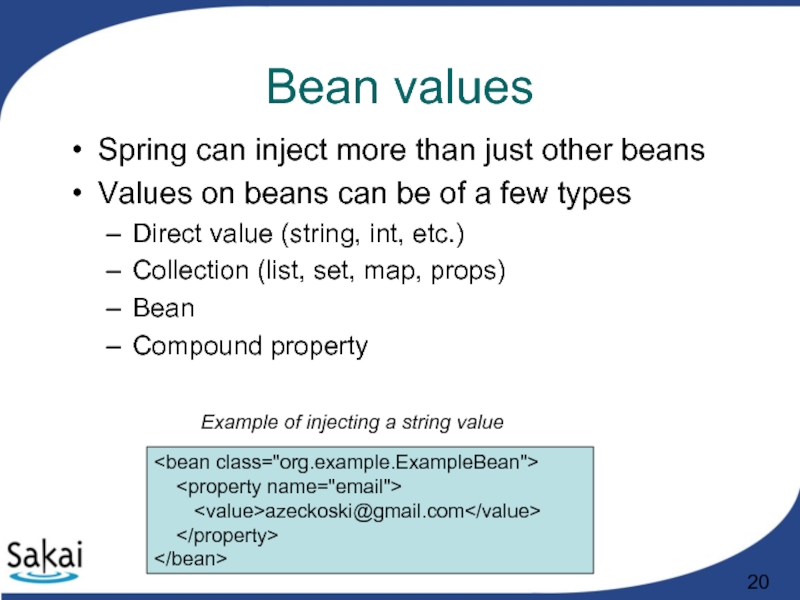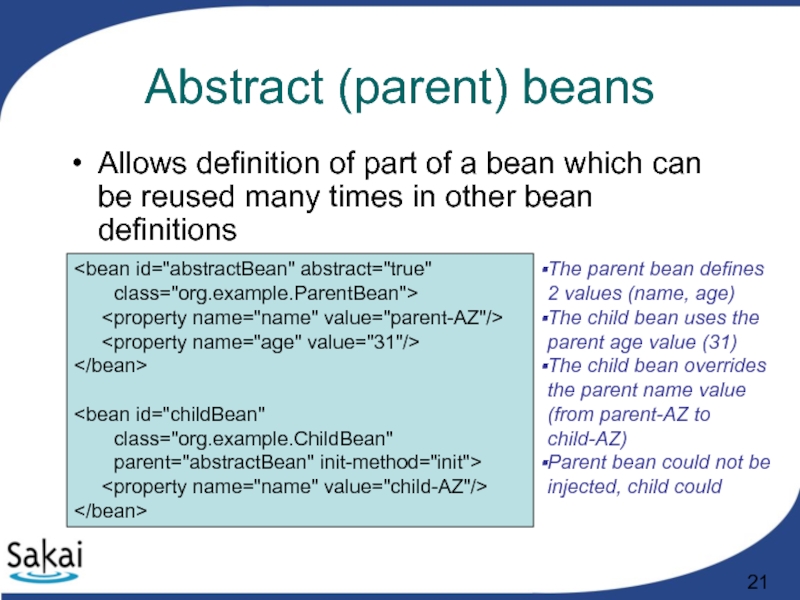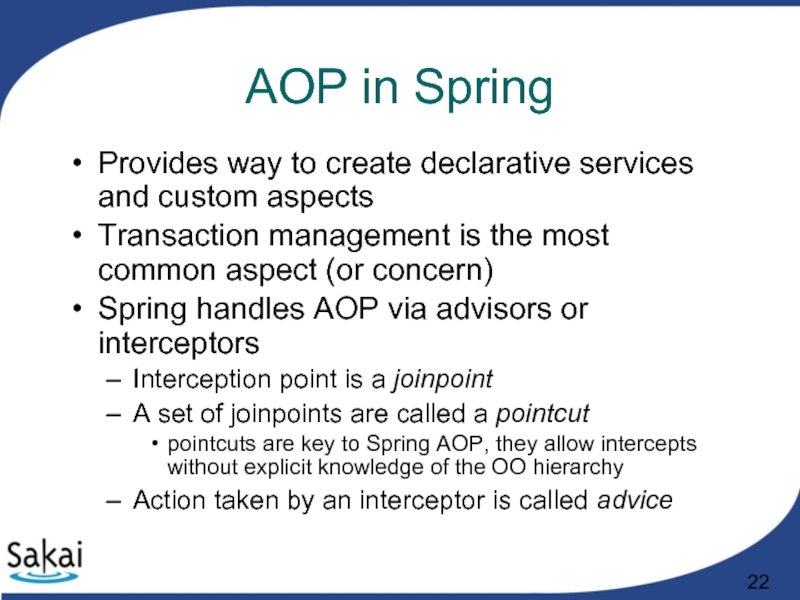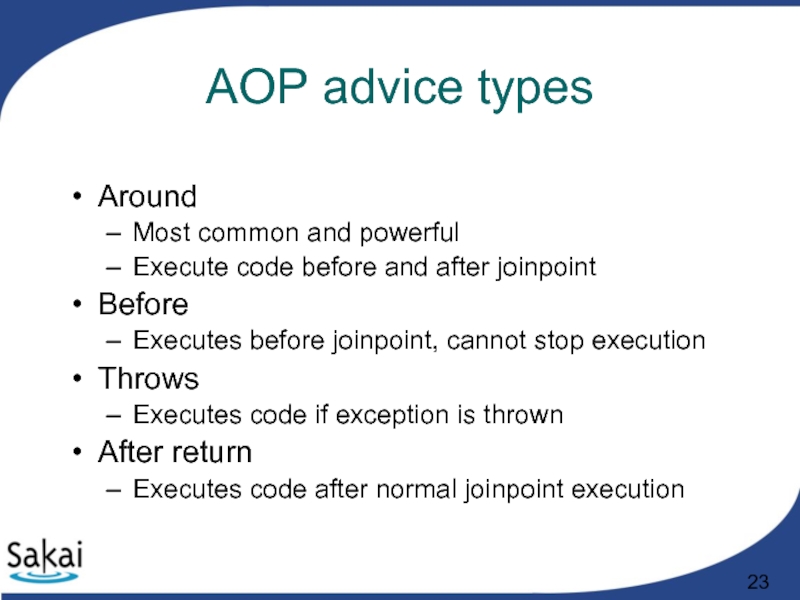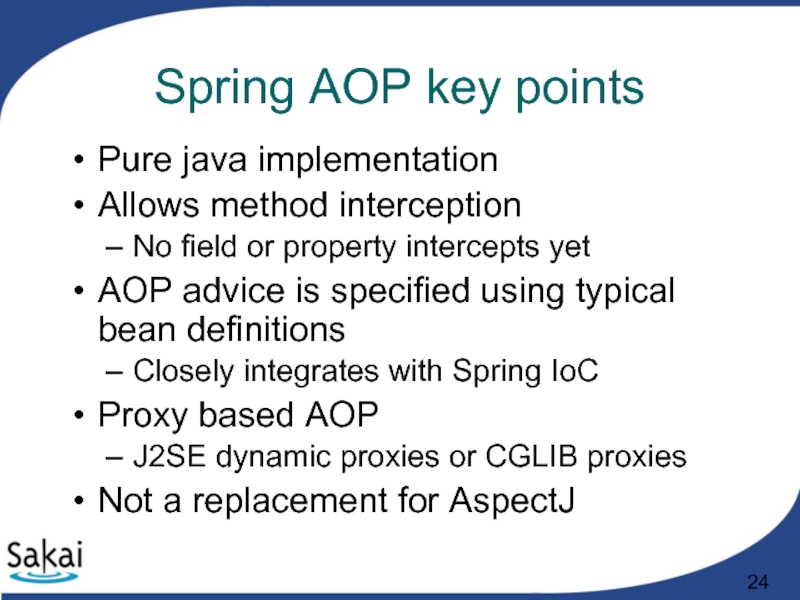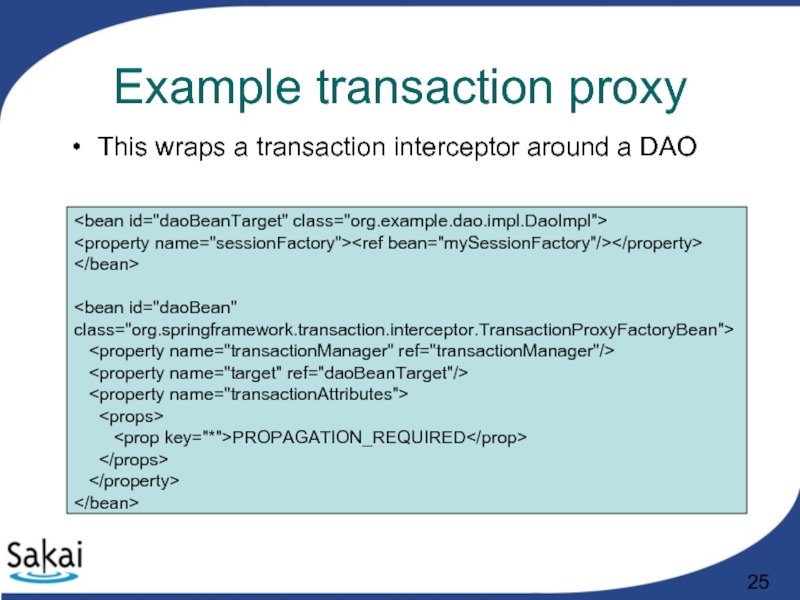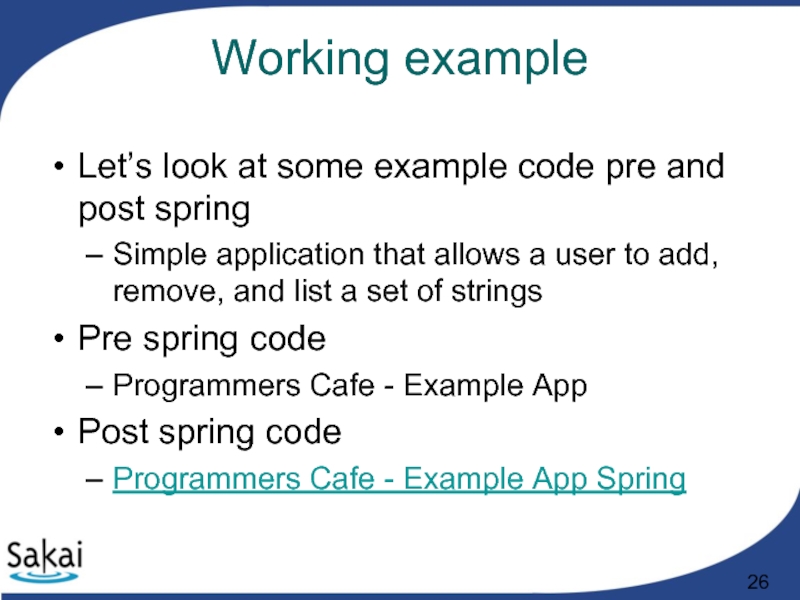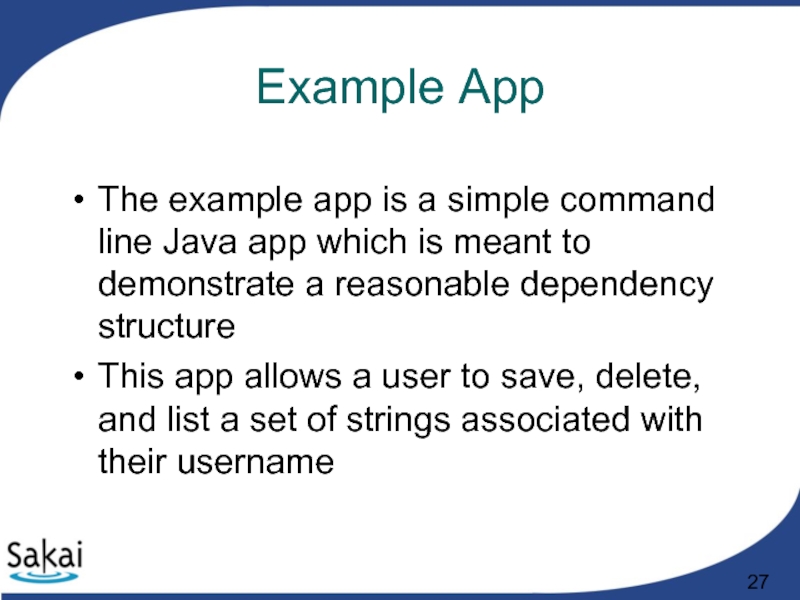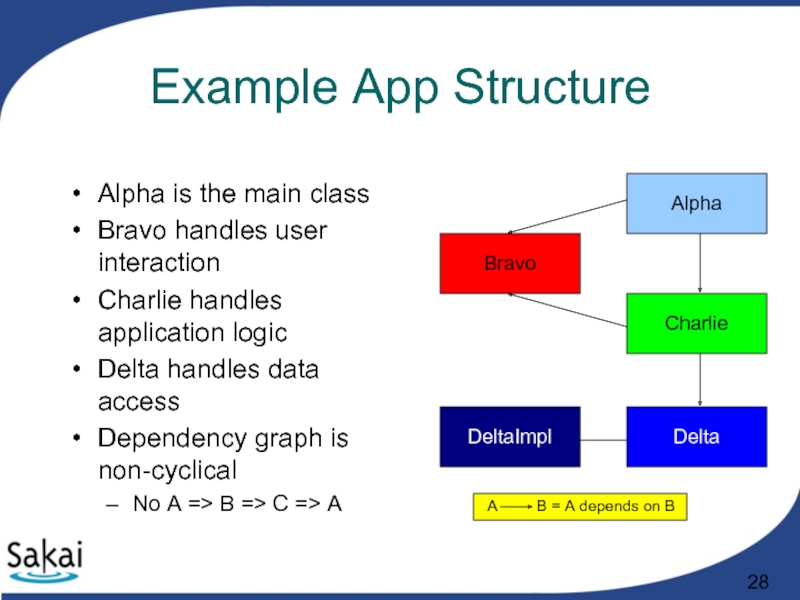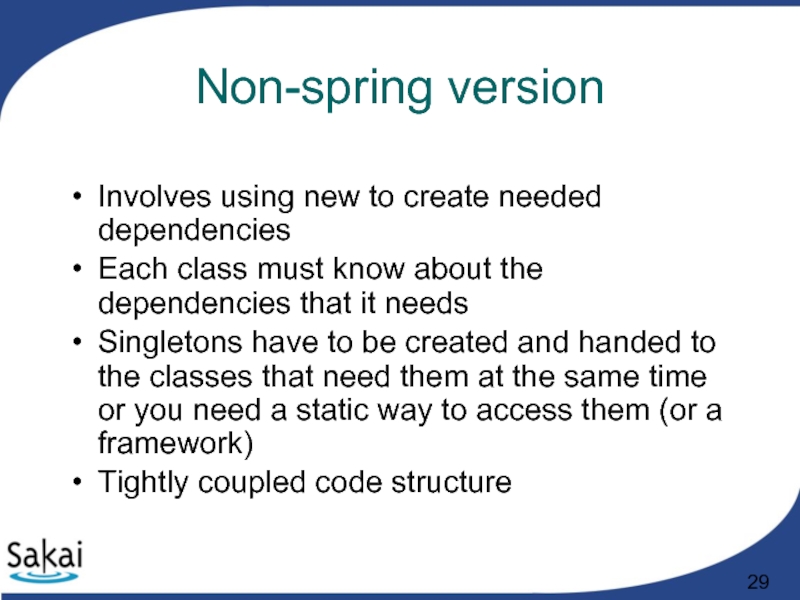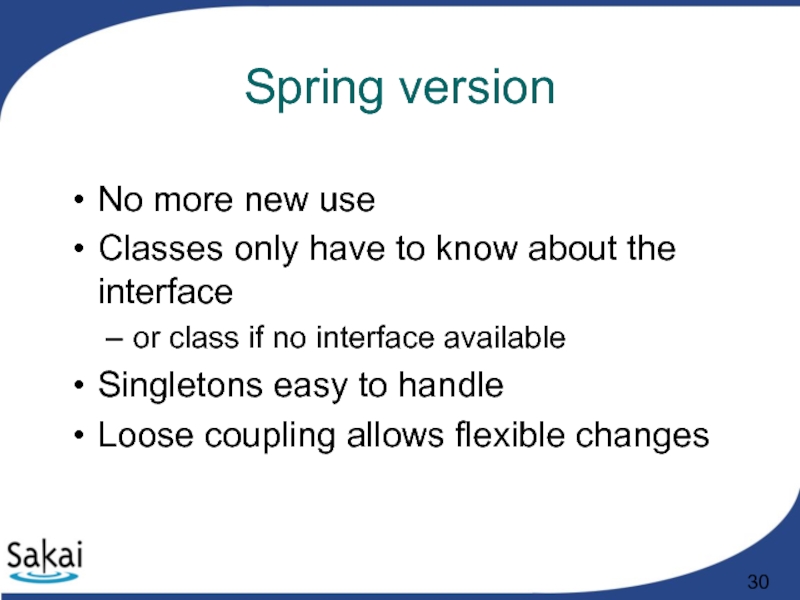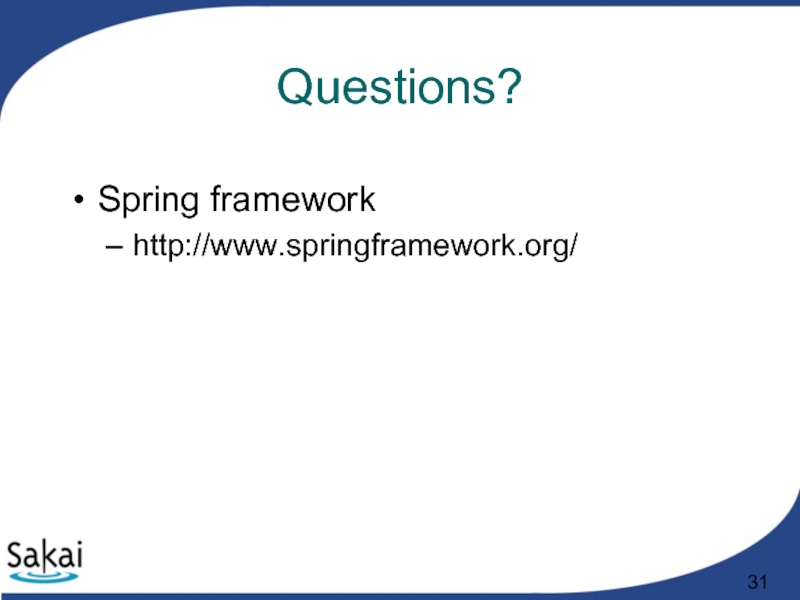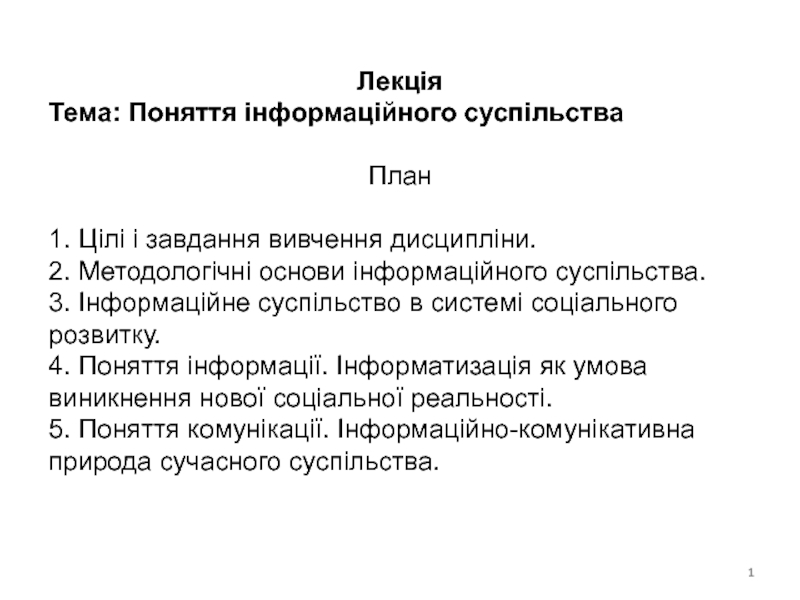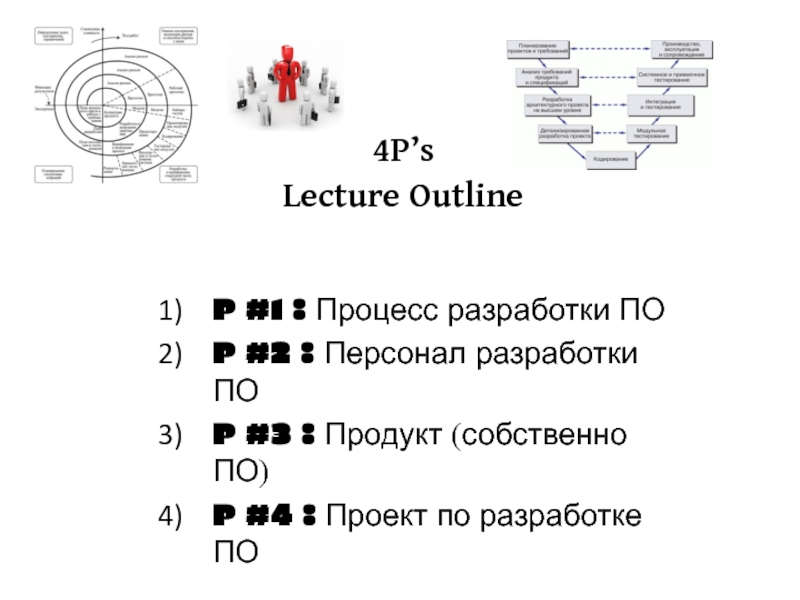- Главная
- Разное
- Дизайн
- Бизнес и предпринимательство
- Аналитика
- Образование
- Развлечения
- Красота и здоровье
- Финансы
- Государство
- Путешествия
- Спорт
- Недвижимость
- Армия
- Графика
- Культурология
- Еда и кулинария
- Лингвистика
- Английский язык
- Астрономия
- Алгебра
- Биология
- География
- Детские презентации
- Информатика
- История
- Литература
- Маркетинг
- Математика
- Медицина
- Менеджмент
- Музыка
- МХК
- Немецкий язык
- ОБЖ
- Обществознание
- Окружающий мир
- Педагогика
- Русский язык
- Технология
- Физика
- Философия
- Химия
- Шаблоны, картинки для презентаций
- Экология
- Экономика
- Юриспруденция
Introduction to spring framework and dependency injection презентация
Содержание
- 1. Introduction to spring framework and dependency injection
- 2. Spring Framework A popular and stable Java
- 3. Spring code structure Spring code base is
- 4. More Spring Considered an alternative / replacement
- 5. What does Spring offer? Dependency Injection Also
- 6. Dependency Injection defined Method to create needed
- 7. Aspect Oriented Programming defined Attempts to separate
- 8. Portable Service Abstractions defined Services that easily
- 9. What is a bean? Typical java bean
- 10. What is a bean definition? Defines a
- 11. Sample bean definition
- 12. What is a bean factory? Often seen
- 13. Beans are created in order based
- 14. How are beans injected? A dependency graph
- 15. Multiple bean config files
- 16. Bean properties? The primary method
- 17. Anonymous vs ID Beans that do
- 18. What is an inner bean? It
- 19. Bean init-method The init method
- 20. Bean values Spring can inject more
- 21. Abstract (parent) beans Allows definition of
- 22. AOP in Spring Provides way to create
- 23. AOP advice types Around Most common and
- 24. Spring AOP key points Pure java implementation
- 25. Example transaction proxy
- 26. Working example Let’s look at some example
- 27. Example App The example app is a
- 28. Example App Structure Alpha is the
- 29. Non-spring version Involves using new to create
- 30. Spring version No more new use Classes
- 31. Questions? Spring framework http://www.springframework.org/
Слайд 2Spring Framework
A popular and stable Java application framework for enterprise development
Ubiquitous
Well established in enterprise Java apps
Time tested and proven reliable
A primary purpose is to reduce dependencies and even introduce negative dependencies
Different from almost every other framework out there
Part of the reason it has been adopted so quickly
URL: http://www.springframework.org/
Слайд 3Spring code structure
Spring code base is proven to be well structured
http://chris.headwaysoftware.com/2006/07/springs_structu.html
Analysis using Structure 101
139 packages
No dependency cycles
Слайд 4More Spring
Considered an alternative / replacement for the Enterprise JavaBean (EJB)
Flexible
Programmers decide how to program
Not exclusive to Java (e.g. .NET)
Solutions to typical coding busywork
JDBC
LDAP
Web Services
URL: http://en.wikipedia.org/wiki/Spring_framework
Слайд 5What does Spring offer?
Dependency Injection
Also known as IoC (Inversion of Control)
Aspect
Runtime injection-based
Portable Service Abstractions
The rest of spring
ORM, DAO, Web MVC, Web, etc.
Allows access to these without knowing how they actually work
Слайд 6Dependency Injection defined
Method to create needed dependencies or look them up
Often called Inversion of Control (IoC)
IoC injects needed dependencies into the object instead
Setters or Contructor
Primary goal is reduction of dependencies in code
an excellent goal in any case
This is the central part of Spring
URL: http://en.wikipedia.org/wiki/Inversion_of_Control
Слайд 7Aspect Oriented Programming defined
Attempts to separate concerns, increase modularity, and decrease
Separation of Concerns (SoC)
Break up features to minimize overlap
Don’t Repeat Yourself (DRY)
Minimize code duplication
Cross-Cutting Concerns
Program aspects that affect many others (e.g. logging)
AspectJ is the top AOP package
Java like syntax, IDE integration
URL: http://en.wikipedia.org/wiki/Aspect-oriented_programming
Слайд 8Portable Service Abstractions defined
Services that easily move between systems without heavy
Ideally easy to run on any system
Abstraction without exposing service dependencies
LDAP access without knowing what LDAP is
Database access without typical JDBC hoops
Basically everything in Spring that is not IoC or AOP
Слайд 9What is a bean?
Typical java bean with a unique id
In spring
Singleton
One instance of the bean created and referenced each time it is requested
Prototype (non-singleton)
New bean created each time
Same as new ClassName()
Beans are normally created by Spring as late as possible
Слайд 10What is a bean definition?
Defines a bean for Spring to manage
Key
class (required): fully qualified java class name
id: the unique identifier for this bean
configuration: (singleton, init-method, etc.)
constructor-arg: arguments to pass to the constructor at creation time
property: arguments to pass to the bean setters at creation time
Collaborators: other beans needed in this bean (a.k.a dependencies), specified in property or constructor-arg
Typically defined in an XML file
Слайд 11
Sample bean definition
public class ExampleBean {
private AnotherBean beanOne;
private YetAnotherBean beanTwo;
private int i;
public void setBeanOne(AnotherBean beanOne) {
this.beanOne = beanOne; }
public void setBeanTwo(YetAnotherBean beanTwo) {
this.beanTwo = beanTwo; }
public void setIntegerProperty(int i) {
this.i = i; }
…
}
Слайд 12What is a bean factory?
Often seen as an ApplicationContext
BeanFactory is not
ApplicationContext is a complete superset of bean factory methods
Same interface implemented
Offers a richer set of features
Spring uses a BeanFactory to create, manage and locate “beans” which are basically instances of a class
Typical usage is an XML bean factory which allows configuration via XML files
Слайд 13
Beans are created in order based on the dependency graph
Often they
Can override this behavior in bean
You can also override this in the factory or context but this is not recommended
Spring will instantiate beans in the order required by their dependencies
app scope singleton - eagerly instantiated at container startup
lazy dependency - created when dependent bean created
VERY lazy dependency - created when accessed in code
How are beans created?
Слайд 14How are beans injected?
A dependency graph is constructed based on the
Beans are created using constructors (mostly no-arg) or factory methods
Dependencies that were not injected via constructor are then injected using setters
Any dependency that has not been created is created as needed
Слайд 15
Multiple bean config files
There are 3 ways to load multiple bean
Load multiple config files from web.xml
Use the import tag
Load multiple config files using Resources in the application context constructor
Recommended by the spring team
Not always possible though
ClassPathXmlApplicationContext appContext = new ClassPathXmlApplicationContext( new String[] {"applicationContext.xml", "applicationContext-part2.xml"});
Слайд 16
Bean properties?
The primary method of dependency injection
Can be another bean, value,
Слайд 17Anonymous vs ID
Beans that do not need to be referenced elsewhere
This bean is identified (has an id) and can be accessed to inject it into another bean
This bean is anonymous (no id)
Слайд 18
What is an inner bean?
It is a way to define a
Always anonymous (id is ignored)
Always prototype (non-singleton)
Слайд 19
Bean init-method
The init method runs AFTER all bean dependencies are loaded
Constructor
Allows the programmer to execute code once all dependencies are present
public class ExampleBean {
public void init() {
// do something
}
}
Слайд 20
Bean values
Spring can inject more than just other beans
Values on beans
Direct value (string, int, etc.)
Collection (list, set, map, props)
Bean
Compound property
Example of injecting a string value
Слайд 21
Abstract (parent) beans
Allows definition of part of a bean which can
parent="abstractBean" init-method="init">
The parent bean defines 2 values (name, age)
The child bean uses the parent age value (31)
The child bean overrides the parent name value (from parent-AZ to child-AZ)
Parent bean could not be injected, child could
Слайд 22AOP in Spring
Provides way to create declarative services and custom aspects
Transaction
Spring handles AOP via advisors or interceptors
Interception point is a joinpoint
A set of joinpoints are called a pointcut
pointcuts are key to Spring AOP, they allow intercepts without explicit knowledge of the OO hierarchy
Action taken by an interceptor is called advice
Слайд 23AOP advice types
Around
Most common and powerful
Execute code before and after joinpoint
Before
Executes
Throws
Executes code if exception is thrown
After return
Executes code after normal joinpoint execution
Слайд 24Spring AOP key points
Pure java implementation
Allows method interception
No field or property
AOP advice is specified using typical bean definitions
Closely integrates with Spring IoC
Proxy based AOP
J2SE dynamic proxies or CGLIB proxies
Not a replacement for AspectJ
Слайд 25
Example transaction proxy
This wraps a transaction interceptor around a DAO
Слайд 26Working example
Let’s look at some example code pre and post spring
Simple
Pre spring code
Programmers Cafe - Example App
Post spring code
Programmers Cafe - Example App Spring
Слайд 27Example App
The example app is a simple command line Java app
This app allows a user to save, delete, and list a set of strings associated with their username
Слайд 28
Example App Structure
Alpha is the main class
Bravo handles user interaction
Charlie handles
Delta handles data access
Dependency graph is non-cyclical
No A => B => C => A
Alpha
Charlie
Bravo
Delta
A B = A depends on B
DeltaImpl
Слайд 29Non-spring version
Involves using new to create needed dependencies
Each class must know
Singletons have to be created and handed to the classes that need them at the same time or you need a static way to access them (or a framework)
Tightly coupled code structure
Слайд 30Spring version
No more new use
Classes only have to know about the
or class if no interface available
Singletons easy to handle
Loose coupling allows flexible changes

